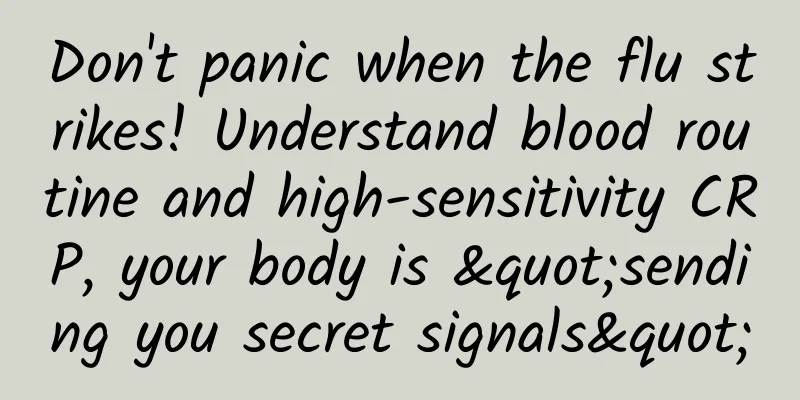Don't panic when the flu strikes! Understand blood routine and high-sensitivity CRP, your body is "sending you secret signals"

|
Don't panic when the flu strikes! Understand blood routine and high-sensitivity CRP, your body is "sending you secret signals" 1. Flu is not a common cold! Your body is "fighting" "A-choo!" A sneeze, two lines of clear nasal discharge, three coughs, and the influenza virus rushes into your body like a battering ram. Do you think it's just a common cold? Wrong! The influenza virus is much more ferocious than the "little thief" of the common cold. It can make your body temperature soar to 39 degrees Celsius within 48 hours, your muscles feel sore as if they were stepped on by an elephant, and your throat so sore that you doubt your life. According to the World Health Organization, influenza causes about 3 million to 5 million severe cases and 290,000 to 650,000 deaths each year. One of the "secret weapons" that doctors use to fight influenza is the blood routine test and the high-sensitivity CRP test - these two test sheets are like the "Morse code" sent by the body, hiding key intelligence about the battle between the virus and the immune system! 2. Blood routine test: the "troop deployment map" of the immune system When the nurse draws a tube of your blood, she is actually taking a census of the "immune army" in your body. Let's put on a microscope and take a look at the three main forces in this "military report": 1. White blood cells: the "total force" of the immune system - Normal value: Adult (4-10)×10⁹/L - Flu: Usually normal or slightly decreased - Cool Facts: White blood cells are not a single cell, but a "multinational force" that includes neutrophils, lymphocytes, etc. 2. Lymphocytes: Special Forces that Fight Viruses - Normal ratio: 20%-40% - Flu alert: The proportion is increasing! It means that the body is mobilizing "virus killers" These lymphocytes are likened to ninjas with samurai swords, specifically hunting down viruses disguised as normal cells. 3. Neutrophils: the "heavy troops" against bacteria - Normal ratio: 50%-70% - Important reminder: Flu is usually normal or low. If it is significantly high, be alert to bacterial infection They are like soldiers driving tanks, and they will bombard bacteria wildly when they encounter them! 3. High-sensitivity CRP: the "smoke alarm" of inflammatory response This name sounds like a coffee brand, but it is actually an upgraded version of the C-reactive protein test. It can detect inflammation 6-8 hours earlier than ordinary CRP, and can be called a "prophet" in the medical field. - Normal value: <3mg/L - Viral infection: Mildly elevated (usually <30 mg/L) - Bacterial infection: skyrocketing (up to 100 mg/L or more) The ultra-sensitive CRP is like the smoke alarm in your kitchen. It makes a "beep" sound when there is a small flame (virus), and it directly sounds the air raid alarm when there is a big fire (bacteria) burning the house! IV. When blood routine test meets high-sensitivity CRP: A Sherlock Holmes-style guide to solving cases How can doctors, like detectives, identify the real culprit through these two reports? Remember this "three-look principle": Indicator combination | Case-solving direction | Treatment plan Lymphocytes ↑ CRP mild ↑ | Viral influenza | Antiviral symptomatic treatment Neutrophils↑ CRP surges | Bacterial infection | Antibiotics strike Complete blood cell count↓ | Be alert to severe illness or complications | Immediate hospitalization for observation 5. Be aware that these misunderstandings will delay your condition! 1. No need to take medicine if your white blood cell count is normal Wrong! White blood cell count may be normal in the early stages of influenza, so the earlier antiviral drugs are used, the better. 2. If your CRP is high, you should take antibiotics Wrong! CRP will also increase slightly during viral infection. Indiscriminate use of antibiotics will damage immunity. 3. Children’s indicators are the same as adults’ Attention! Children's lymphocyte ratio is naturally high, so don't scare yourself. VI. Ultimate survival guide: essential knowledge for flu season 1. Golden 48 hours: Get a flu antigen test as soon as possible after symptoms appear 2. The best time to test blood: 24 hours after fever, the test is more accurate Conclusion Next time when you get a blood test report, remember to smile wickedly at the mirror: "Ha, little virus, I have deciphered your battle plan!" But remember - leave professional matters to professionals, and let the doctor make the final decision on all test results! (The data in this article refer to "Internal Medicine (9th Edition)" and the National Health Commission's "Influenza Diagnosis and Treatment Program") Dongguan Dalang Town Community Health Service Center Liu Jinhai |
<<: Beware! Staying up late is quietly draining your body! Have you been affected by these hazards?
>>: Alcohol and drugs a deadly combination
Recommend
What to do if you have leucorrhea during pregnancy
For every newly married couple, pregnancy becomes...
Women often dream of flying
Sometimes when watching fantasy TV dramas, many p...
What happens if adenomyosis is not treated?
Adenomyosis is a disease that occurs in the femal...
Why does the uterus bleed heavily?
There are generally two well-known types of femal...
Can you pinch the philtrum at ordinary times? What is the effect of pressing the philtrum?
Traditional Chinese medicine is an indispensable ...
Breastfeeding breast pain
When breastfeeding, some mothers who have poor mi...
Effects of prolonged sitting during pregnancy on the fetus
Pregnant women should try to keep their bodies in...
What ointment is effective for vulvar leukoplakia
My private parts have been itching and uncomforta...
How to confirm pelvic inflammatory disease
Pelvic inflammatory disease is a gynecological di...
What to do if taking birth control pills causes irregular menstruation?
Taking birth control pills can cause irregular me...
How much does it cost to have a medical abortion?
Generally speaking, the cost of medical abortion ...
Why do girls have wet feet?
There is a reason why many men have smelly feet. ...
A woman dreams of dyeing her hair
The scenes in dreams are always varied and usuall...
My lower body is always dirty and there is brown blood
For women, menstruation is an effective way to he...
Introduction to the treatment of endometrial hyperplasia by curettage and dilation
Endometrial hyperplasia is a problem that many wo...









